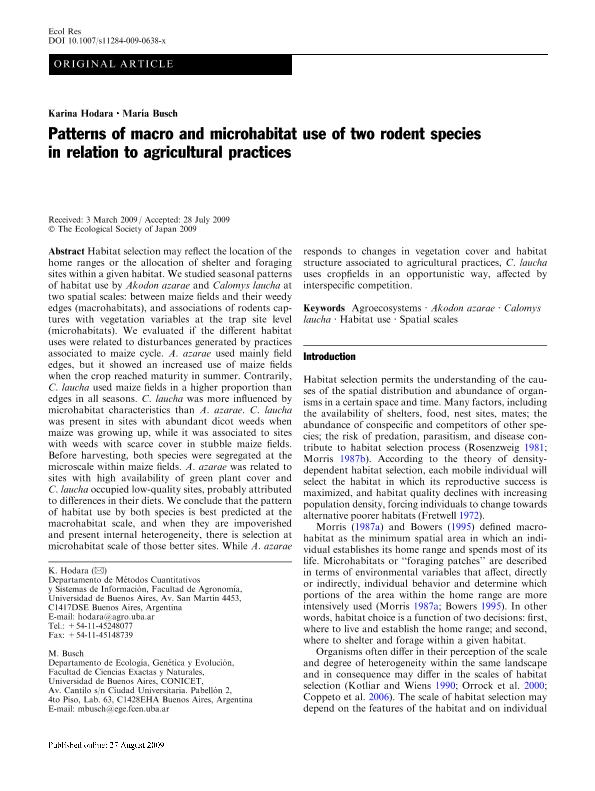Artículo
Patterns of macro and microhabitat use of two rodent species in relation to agricultural practices
Fecha de publicación:
01/2010
Editorial:
Wiley
Revista:
Ecological Research
ISSN:
0912-3814
Idioma:
Inglés
Tipo de recurso:
Artículo publicado
Clasificación temática:
Resumen
Habitat selection may reflect the location of the home ranges or the allocation of shelter and foraging sites within a given habitat. We studied seasonal patterns of habitat use by Akodon azarae and Calomys laucha at two spatial scales: between maize fields and their weedy edges (macrohabitats), and associations of rodents captures with vegetation variables at the trap site level (microhabitats). We evaluated if the different habitat uses were related to disturbances generated by practices associated to maize cycle. A. azarae used mainly field edges, but it showed an increased use of maize fields when the crop reached maturity in summer. Contrarily, C. laucha used maize fields in a higher proportion than edges in all seasons. C. laucha was more influenced by microhabitat characteristics than A. azarae. C. laucha was present in sites with abundant dicot weeds when maize was growing up, while it was associated to sites with weeds with scarce cover in stubble maize fields. Before harvesting, both species were segregated at the microscale within maize fields. A. azarae was related to sites with high availability of green plant cover and C. laucha occupied low-quality sites, probably attributed to differences in their diets. We conclude that the pattern of habitat use by both species is best predicted at the macrohabitat scale, and when they are impoverished and present internal heterogeneity, there is selection at microhabitat scale of those better sites. While A. azarae responds to changes in vegetation cover and habitat structure associated to agricultural practices, C. laucha uses cropfields in an opportunistic way, affected by interspecific competition.
Palabras clave:
Agroecosystems
,
Akodon Azarae
,
Calomys Laucha
,
Habitat Use
,
Spatial Scales
Archivos asociados
Licencia
Identificadores
Colecciones
Articulos(IEGEBA)
Articulos de INSTITUTO DE ECOLOGIA, GENETICA Y EVOLUCION DE BS. AS
Articulos de INSTITUTO DE ECOLOGIA, GENETICA Y EVOLUCION DE BS. AS
Citación
Hodara, Karina; Busch, Maria; Patterns of macro and microhabitat use of two rodent species in relation to agricultural practices; Wiley; Ecological Research; 25; 1; 1-2010; 113-121
Compartir
Altmétricas




